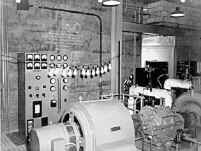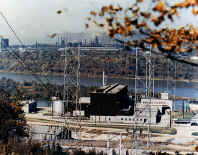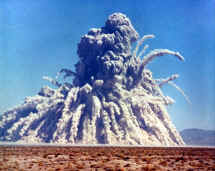Energy Timeline
from 1951 to 1970
1939-1950 1951-1970 1971-1980 1981-1990 1991-2000 2001 2002 2003 2004
December 20, 1951
 The Experimental Breeder Reactor No. 1 located at the National Reactor Testing Station near Arco, Idaho, produces the first electric power from a nuclear reactor. The Experimental Breeder Reactor No. 1 located at the National Reactor Testing Station near Arco, Idaho, produces the first electric power from a nuclear reactor.
October 31, 1952
The Atomic Energy Commission detonates the first thermonuclear device, code-named "Mike," at Enewetak Atoll in the Pacific. The device explodes with a yield of 10.4 megatons.
January 20, 1953
Dwight D. Eisenhower is inaugurated President.
December 8, 1953
President Eisenhower delivers his "Atoms for Peace" before the United Nations and proposes an international agency to promote peaceful applications of nuclear energy.
January 24, 1954
The Navy launches the first nuclear-powered submarine, U.S.S. Nautilus.
August 30, 1954
President Eisenhower signs the Atomic Energy Act of 1954, opening the way for development of a civilian nuclear power program.
December 23, 1957
 The Shippingport Atomic Power Station, the world's first full-scale nuclear power plant, becomes operational at Shippingport, Pennsylvania. The Shippingport Atomic Power Station, the world's first full-scale nuclear power plant, becomes operational at Shippingport, Pennsylvania.
August 22, 1958
President Eisenhower announces a moratorium on nuclear weapons testing to begin on October 31.
January 20, 1961
John F. Kennedy is inaugurated President.
August 13, 1961
East Germany begins construction of the Berlin Wall, which closes all land routes between East and West Berlin.
September 1, 1961
The Soviet Union breaks the nuclear test moratorium.
September 15, 1961
The United States resumes nuclear weapons testing.
July 6, 1962
 As part of the Plowshare program seeking to develop peaceful uses for nuclear explosives, the Atomic Energy Commission conducts the Sedan test at the Nevada Test Site. As part of the Plowshare program seeking to develop peaceful uses for nuclear explosives, the Atomic Energy Commission conducts the Sedan test at the Nevada Test Site.
October 1962
Reconnaissance reveals Soviet missiles in Cuba. The United States blockades Cuba for 13 days until the Soviet Union agrees to remove its missiles.
August 5, 1963
The United States, Great Britain, and the Soviet Union sign the Limited Test Ban Treaty prohibiting underwater, atmospheric, and outer space nuclear tests. Nuclear testing continues underground.
November 22, 1963
Lyndon B. Johnson becomes President.
November 1965
The Atomic Energy Commission makes the Liquid Metal Fast Breeder Reactor its highest reactor development priority.
November 9, 1965
The first major power blackout covers the northeast United States.
January 1, 1969
President Johnson signs the National Environmental Policy Act.
January 20, 1969
Richard M. Nixon is inaugurated President.
March 5, 1970
The United States, Great Britain, the Soviet Union, and forty-five other nations sign the Treaty for the Nonproliferation of Nuclear Weapons.
September 23, 1970
Electric power "brownouts" hit northeast during heat wave. |